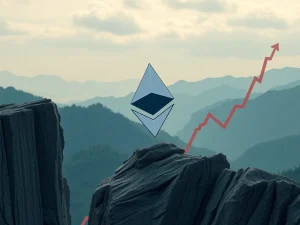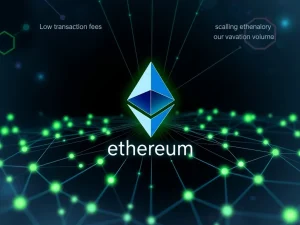Ether ETFs Ignite Unprecedented Growth: $13.7B Inflows Fuel Ethereum’s Surge

Ethereum, the leading smart contract platform, is experiencing a remarkable surge in institutional interest. **Ether ETFs** recently hit an astounding $13.7 billion, demonstrating unprecedented growth. This momentum, combined with expanding **corporate ETH treasuries**, signals a pivotal moment for the cryptocurrency. Market participants are observing a significant revival in Ethereum’s value proposition, positioning it for continued expansion.
Ether ETFs Drive Unprecedented Inflows
Since their US debut in July 2024, Ether spot exchange-traded funds (ETFs) have shown consistent and robust growth. Notably, inflows into Ether (ETH) funds climbed by a significant 44% this month. These inflows rose from $9.5 billion on August 1 to an impressive $13.7 billion by August 28. This data comes from cryptocurrency research platform SoSoValue.com.
Renewed institutional demand fuels this momentum. Fabian Dori, Chief Investment Officer at Sygnum, explained the shift. “After an extended period of underperformance relative to Bitcoin and a souring investor sentiment, Ethereum has recently experienced a significant revival in the recognition of both its adoption rate and value proposition,” Dori stated. Therefore, institutional confidence in Ethereum’s long-term potential appears to be strengthening.

Corporate ETH Treasuries Expand Significantly
Beyond ETFs, a growing number of companies are now adopting ETH-based corporate treasuries. While Bitcoin (BTC) has historically dominated corporate treasury discussions, Ether treasuries are rapidly gaining traction. According to StrategicETHReserve, companies currently hold 4.4 million ETH. This represents 3.7% of the total supply and is valued at approximately $19.18 billion.
Several factors contribute to this rise. “A strong driver for that is regulation such as the Genius Act that provides traditional investors with the comfort to build infrastructure and use cases on this new technology,” Dori commented. This regulatory clarity offers a foundation for broader corporate adoption. Furthermore, these corporate holdings are seen as a stable, long-term investment. Geoffrey Kendrick, Standard Chartered’s global head of digital assets research, affirmed this view. He noted, “Treasury companies are a massive buyer. They won’t sell. So, yes, the impact will stay.” This suggests a sustained floor for demand.
Ethereum Price Surges Amidst Strong Demand
The combined force of increased ETF inflows and growing corporate treasuries has had a clear impact on the **Ethereum price**. Supported by this robust investor demand, Ether’s price gained nearly 27% in August. It rose from approximately $3,406 on August 1 to $4,316 by Friday, according to Crypto News Insights Markets Pro. This upward trajectory reflects strong market confidence.
The consistent buying pressure from both institutional funds and corporate balance sheets indicates a fundamental shift. Investors are increasingly recognizing Ethereum’s utility and potential for future growth. This collective buying behavior suggests a robust support level for the asset. Consequently, many analysts remain optimistic about its short-to-medium term prospects. The market appears to be pricing in future developments and broader adoption.

The Critical Juncture of Ethereum’s Roadmap
Industry observers are optimistic about Ethereum’s future. However, they also highlight the coming months as critical for the network’s ecosystem. “**Ethereum’s roadmap** is entering a critical inflection point,” Bitfinex analysts told Crypto News Insights. Upcoming upgrades are set to significantly enhance smart contract efficiency. They will also improve validator usability. This advances Ethereum’s competitiveness as an institutional settlement layer.
Furthermore, innovations like restaking via EigenLayer are gaining traction. The growth of Layer 2 (L2) rollup activity is also generating real protocol revenues. These developments are attracting significant developer attention back to the ecosystem. Ethereum is steadily advancing its upgrade cadence. Key milestones aim for greater scalability and long-term global utility. For instance, the Pectra upgrade in May expanded validator caps and introduced account abstraction. The Fusaka hard fork, scheduled for November 5, will implement PeerDAS. This aims to ease node workloads and improve data availability across the network.
Future Outlook and Revenue Generation
Despite the positive momentum, Ethereum’s revenue generation has yet to fully catch up. In the past 30 days, the network generated $41.9 million in fee revenue. This amount is a fraction of Tron’s $433.9 million over the same period. Nevertheless, the ongoing technological advancements and increasing institutional adoption paint a promising picture. The network’s foundational improvements are setting the stage for future revenue growth.
The consistent increase in **ETH inflows** through ETFs and corporate treasuries underscores a strong belief in Ethereum’s long-term potential. As the network progresses through its ambitious roadmap, its position as a leading decentralized platform will likely solidify further. This period represents a transformative phase, promising significant evolution and increased utility for the Ethereum ecosystem. Therefore, investors and developers alike are watching these developments closely, anticipating a new era for the blockchain.









